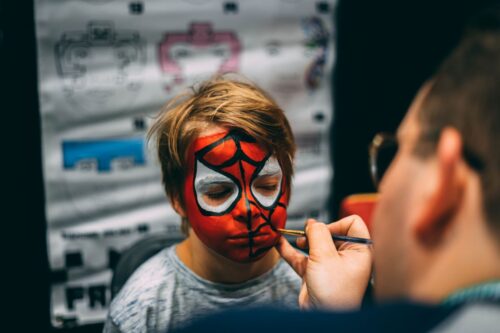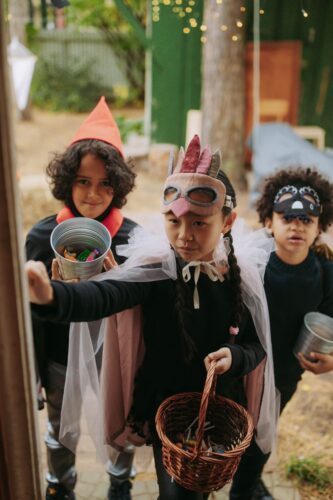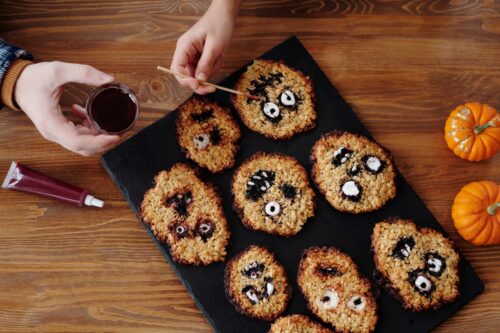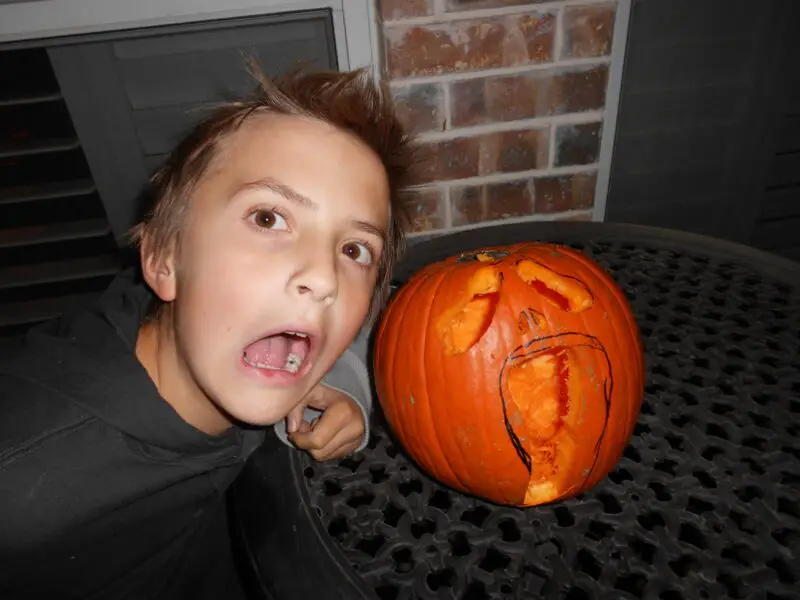Playing Dress Up: How to Make Trick or Treating Fun
Socializing can often be hard for children with autism, and in today’s times, many kids are lonelier than ever before. It’s important to give kids the right opportunity to socialize with others, and playing dress up and going trick or treating on Halloween can be a great way to do that.

Assuming the idea of trick or treating works for your child’s physical, emotional, and dietary requirements, playing dress up to go trick or treating or attending events such as fall harvest celebrations, can be the perfect time and place for your child to make friends that can last a lifetime.
They just need the right opportunity and situation that works best for them.
Many organizations offer alternative trick-or-treating activities such as carnivals, playing dress up in costumes to wear at the zoo or parks, or simple events like pumpkin decorating at the local pumpkin patch. While playing dress up is typically a part of Halloween or fall festivals, costumes are always optional.
And a “costume” can be as simple as face painting or a cute shirt, if your child isn’t comfortable with playing dress up. The key is to find a safe and fun environment that may include classmates, friends, or simply family.
While Halloween can be an exciting time for kids, the holiday can be daunting for others (whether they are neurotypical or have special needs). With some planning and preparation, it can also be a great opportunity for autistic kids to practice social skills and make new friends.
Again, of course, this depends on your child’s personality and personal preferences regarding playing dress up.
Ways to Make Halloween A Positive Experience
As an adult on the spectrum, I remember my childhood years of trick or treating and costume-wearing with great joy. Looking back, I think it is because of these reasons:
- I always got to choose my costume and my parents never made a big deal out of it if I took off parts of it I found uncomfortable
- I went trick or treating in my small neighborhood, accompanied by my parents and older sister, and nobody made a fuss when I was ready to return home (my parents would sometimes do the divide and conquer assignments)
- If I was home and there were still trick-or-treaters, I got to help pass out candy, which was always fun
- My parents let me pick out candy that I liked, and then we donated the rest to either the school or local places like the fire department so that I didn’t go overboard with it
- I loved capes, and sometimes my costumes were quite simplistic but with a cape, which made me feel like a superhero
Additionally, here are some tips to help make playing dress-up and trick-or-treating a positive social experience for your autistic child:
Finding a Buddy
Pairing your autistic child with a buddy can provide much-needed social support during trick or treating. Having a trusted companion by their side can help model appropriate social interactions, prompt your child when needed, and assist in conversations.
Here are some options for finding a suitable trick-or-treating buddy and playing dress-up together:
- Sibling or family member: If your child has a sibling, cousin, or other family member close in age, ask them to trick-or-treat together. Siblings already have rapport, so this is an easy pairing.
- Family friend: Check with close family friends who have children near your child’s age. Explain your goals for your child in terms of socialization so they know how they can help.
- Classmate: Contact parents from your child’s class and arrange for them to pair up during trick-or-treating. Classmates already know each other and may live nearby.
- Therapist or aide: Some children may do best pairing with a therapist, teacher’s aide, or other professional they trust. This person can act as a conduit for interactions.
The key is finding someone patient, empathetic, and familiar to your child. Tell the buddy about your child’s autism and needs. With the right buddy, your child will have social and emotional support.
Being Selective About Houses to Visit
Carefully choosing which houses to visit can help avoid situations that cause sensory or social stress for your autistic child. Here are some things to consider:
- Neighbors you know: Only visit the homes of neighbors who know your child and are understanding of autism. Skip houses of strangers or acquaintances whose reactions are uncertain.
- Avoid crowds: Steer clear of houses with long lines or big hordes of kids. These can heighten sensory overload and anxiety.
- Allergies: If your child has food allergies, visit houses giving out non-food treats first. You want to ensure they get allergy-free candy.
- Well-lit houses: Seek out houses that are well-lit so your child can see and process the environment and people. If your child is tentative about the “spooky” aspect of Halloween, locate homes that reflect more of a pumpkin and fall theme rather than ones with cackling witches or scary ghouls.
- Escape route: Always have an exit strategy. Skip homes without an easy path away if your child needs to retreat.
Being selective means fewer stops, but each stop will be quality. Your child will interact in a more controlled, positive setting with less uncertainty.
Using Scripts and Prompts

- Trick-or-treat: “Trick or treat” or “Happy Halloween” when the door opens. Practice until it’s familiar and comfortable.
- Thank you: “Thank you” after receiving candy. Make sure they know when to provide this prompt.
- Introductions: “I’m [name].” Have them announce their name or costume if asked. If they are shy or don’t answer, remember that is okay too, and don’t pressure them.
- Questions: “[Buddy’s name] is my friend” or “[Favorite candy] is my favorite.” Give responses they can use if questioned.
- Exiting: “Bye!” or “Happy Halloween!” when leaving. A farewell script offers closure.
Roleplay the scripts and write them on index cards or a communication app if needed. Also, prepare some backup prompts in case you need to quietly coach your child.
With practice, these scripts will give them confidence.
Playing Dress Up and Picking the Right Costume
Allow your autistic child to select their Halloween costume if playing dress up, as feeling ownership will increase their eagerness to wear it. Keep these factors in mind for playing dress up and costume success:
- Comfort is key: Avoid heavy, restricting, scratchy, or irritating costumes. Seek soft, breathable fabrics. Keep in mind any tactile requirements your child may have.
- Keep it simple: Skip masks, makeup, wigs, or elaborate costume parts when playing dress up that could cause sensory issues. Opt for simple pieces that are easy to get on and off.
- Go for recognizable: Classic Halloween costumes like ghosts, witches, superheroes, and cats are easily understood by others. Avoid abstract or obscure costumes if possible when playing dress up, unless that is what your child insists on. If it is, have a conversation with your child so that they will not get frustrated if others don’t understand what character or thing they are.
- Include autism-friendly accessories: Incorporate fidget toys, sunglasses, hats, or other accessories when playing dress-up to help them self-regulate and feel secure.
- Offer choices: Provide 2-3 costume options that meet your child’s needs. Allow them to make the final selection.
The right costume when playing dress up can give your child a sense of fun and self-expression. Consult them and ensure sensory needs are met.
Packing Familiar Items
In their treat bag or a special comfort bag, letting your autistic child carry some familiar self-soothing items can ease anxiety. Consider packing these items when playing dress up and participating in festivities:
- Fidget toys like fidget spinners, Rubik’s cubes, and squishy stress balls to keep hands busy
- Headphones and music players with calming music or sounds to drown out loud environments
- Sunglasses to dim overwhelming visual stimulation
- Favorite snacks or bottled water in case unfamiliar treats are offered
- Written scripts, communication cards, or a tablet device to aid interaction
- Stuffed animal, blanket fragment, or other tactile comfort object
- Light-up toys that are bright or even glow sticks that can be worn or carried can add to the fun and provide additional safety
- Safety whistle if your child is independent and will carry it
Having these tools on hand will empower your child to independently regulate their emotions and senses during trick-or-treating.
Scheduling Breaks from Playing Dress Up and Trick or Treating
Make sure to schedule sensory breaks during trick or treating to prevent your autistic child from becoming overwhelmed. Watch for signs of overstimulation like irritability, agitation, yelling, or shutting down. When you see these cues, guide them away from the activity and take a break in a quiet area. Useful break activities include:
- Sitting in the car with calming music
- Returning home briefly for some alone time in their room, or call it good if that seems to be enough for your child
- Remove the costume temporarily if playing dress up to see if any sensory issues were causing the child to feel overwhelmed
- Stepping into a nearby shop or quiet yard to unwind
- Getting a drink or snack to reset blood sugar and hydration
- Taking sensory-friendly toys out of their bag to play with
- Deep breathing, stretching, or fidgeting to release tension
Keep breaks low-key with limited talking and interaction. Start trick-or-treating again if and when your child feels recharged and ready. Having planned breaks will make the experience more sustainable.
Processing Afterwards
Once playing dress up and going trick-or-treating concludes, take time to gently review the experience with your child with autism and address what went well and any difficulties. Keep your tone positive and celebratory, and praise their effort and any social successes, like asking for candy or interacting with other children. If they face challenges like sensory overload or confusion navigating interactions, talk through what could help next time. You want them to feel proud, bolster their self-esteem, and be willing to socialize in the future.
Decorating Strategies

- Ask your child what decorations they like and dislike, and leave out any distressing items. Focus on their favorites.
- Use pumpkin or bat string lights rather than scary music, animatronics, or flashing lights. These provide a subtle festive cue.
- Add homemade sensory-friendly decorations like tissue paper ghosts, paper bats, or spiderwebs made from yarn or ribbons. Skip realistic spiders and webs.
- Line your walkway with orange and black balloons, streamers, inflatable characters like Toy Story or Snoopy, and other cheerful markers.
- Display a personalized “Happy Halloween” yard sign with their name and some of their favorite characters.
- Set up an arts and crafts table indoors to make non-scary decorations like paper pumpkins, stickers, or colored chalk drawings.
- Your home environment should provide safety, clarity, and upbeat festivity. Decorations can easily be adapted to your child’s needs and sensitivities.
- Consider baking sensory-friendly treats and using festive dishware or colors as decorating options.
Hosting Trick-or-Treaters
If your child is receptive and understands the concept that treats will be given away and not, another great social opportunity is playing dress up and having them help pass out candy to other trick-or-treaters who come to your door. Here are some tips:
- Set expectations ahead of time for how many houses or minutes they will participate.
- Create a visual schedule showing each step: playing dress up by putting on costume, sitting by the door, greeting trick-or-treaters, saying how many pieces of candy to give, saying “Happy Halloween,” placing candy in bag/bucket, closing door. Review it.
- Set a timer or other visual cue for when their participation time starts and ends.
- Place a sensory activity like a fidget toy or noise-canceling headphones within reach in case of overstimulation.
- Offer rewards like their favorite snack or stickers after completing their hosting time.
With prepping and expectations, greeting trick-or-treaters provides great social practice in a controlled setting.
Safety Considerations
Safety should be your top priority. Here are some extra precautions when trick-or-treating with an autistic child:
- Ensure your child’s costume has reflective tape to be well-lit at night. Use glow sticks and flashlights if playing dress up and wearing a costume in the evening.
- write your name, phone number, and any relevant info (such as “autistic”) on the inside of their costume.
- Take a current photo of your dressed-up child just before going out in case you get separated.
- Set a time limit or number of blocks to trick-or-treat and stick to it. Don’t stay out too late when they are tired.
- Do a test run of their costume and bag beforehand to ensure nothing impedes movement or senses.
- Keep dogs indoors on Halloween if your child fears them. Carry dog treats if needed to create positive associations.
- Carefully supervise street crossings. Hold their hand firmly.
Taking basic safety steps will allow you to relax and let them enjoy this milestone holiday experience.
With some planning and preparation, playing dress up and trick-or-treating can be a fun way for autistic children to practice vital social skills in an encouraging environment. Don’t avoid trick-or-treating just because your child struggles with social interaction. Use this guide to make it an opportunity for them to enjoy aspects of Halloween or fall celebrations that work for them!
My Own Experiences with Halloween
I always enjoyed Halloween as a child, in part because it was a fun family celebration. I always enjoyed playing dress up and went trick or treating with my older sister, who loved dressing up even more than I did.
While I enjoyed the experience, I remember that I typically didn’t want to do it for that long, and was more than satisfied with going to homes in a small section of my neighborhood and then calling it a night.
While I loved picking out my costume, sometimes it wasn’t always the most comfortable outfit to wear for a long time.
Usually, I picked super hero type costumes like Spiderman and Buzz Lightyear. When I was older I opted for more scary costumes like the Scream character or the invisible man, although I also didn’t wear the masks for very long at all.
I think one year I wore a mask for only a few minutes, but that was okay with my family, which I appreciated.

My family always decorated our home for Halloween and we participated in fun activities like pumpkin decorating and/or carving, making Halloween cookies, and sometimes cooking s’mores in the backyard after we finished our rounds.
My mom always looked over our “haul” afterward and limited treats, and then it seemed like they magically disappeared over a short time. That was fine with me too, as it was more about the event than eating a lot of candy.
We typically donated extra candy (unopened and individually wrapped, of course) to groups like nursing homes and to send to soldiers overseas. That was a win-win for everyone involved.
If your child loves Halloween, then embrace the experience and make it fun by playing dress-up and other activities! If not, that is okay too. There are alternative ways to celebrate fall and enjoy the season!
When kids get too old for trick-or-treating, many turn to going to haunted houses as teens or adults. Read my blog about deciding whether to go to scary haunted houses and why it’s perfectly okay to say no!
Additional Challenges Individuals with Autism Face
Learn more about other issues that many autistics face:
-
- New Research Reveals Autism Mental Health Linked to These Disorders
- Surprising Connections: Why Autism and Apraxia Share Common Ground
- Breaking the Silence: Startling Insights about Autism and Depression
- Autism and Holidays: Why Special Occasions Can Be Challenging
- Top 10 Autism Stereotypes That Need to Go Away
- 6 Fascinating Facts About Autism You Probably Didn’t Know
- 8 Popular Ways to Manage and Master Autistic Social Awkwardness
- Autism and Poor Hygiene: The Smelly Truth to Overcome
- Breaking Down Barriers that Challenge Autism and Friendships
- Anxiety and Autism: 5 Powerful Strategies to Conquer Emotions
- Growing Up Autistic: How I Overcame Challenges and Now Thrive
- Ways to Tackle Autism Fireworks Anxiety and Sensory Overload
- Autism Family Support: 5 Ways to Achieve A Happy Household
- Behind Closed Doors: Exploring the Dark Side of Autism and Aggression